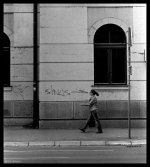The whole idea that you can see what happens in front of you is problematic. The brain "sees" all sorts of things and misses things that the eyes don't or do see. To try one fairly famous experiment, watch the following film of some students in black shirts and white shirts bouncing two basketballs to each other, and try to note how many times each team passes the ball (kind of a long download)--
http://viscog.beckman.uiuc.edu/grafs/demos/15.html
Did you notice anything unusual during the game? Most people don't. If you didn't, then watch it again and ask yourself how you could have missed it. It wasn't mirror blackout.
I feel that I see the action at the moment of exposure when I'm using an SLR, even though I know that the viewfinder is blacked out at that precise instant, just as I experience the motion in a film projected at 24 fps as continuous motion.
For a fairly accessible (if not entirely up to date) account of such phenomena, I recommend Daniel Dennett's book, _Consciousness Explained_.
I feel that I see the action at the moment of exposure when I'm using an SLR, even though I know that the viewfinder is blacked out at that precise instant, just as I experience the motion in a film projected at 24 fps as continuous motion.
I have a pretty good idea of what the lens is seeing when I'm using a large format camera to make portraits, even though there might be quite some time between focusing, stopping down the lens, closing the shutter, inserting the filmholder, removing the darkslide, waiting for the right expression, and firing the shutter.
When I use a RF or viewfinder camera or TLR, my eye sees the action at the moment of exposure, but I don't know that my brain is more conscious of having seen it.


